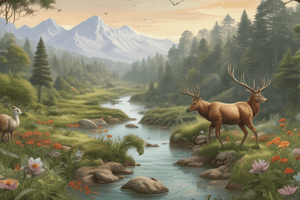Podcast
Questions and Answers
What is a characteristic of rare species?
What is a characteristic of rare species?
- Having a narrow ecological niche (correct)
- Being found in multiple geographic areas
- Having a large population size
- Having a wide ecological niche
What is an example of a cause of rarity?
What is an example of a cause of rarity?
- Conservation efforts
- Species reintroduction
- Education and awareness
- Habitat destruction (correct)
What is a type of rare species?
What is a type of rare species?
- Endemic species (correct)
- Common species
- Vulnerable species
- Invasive species
What is a conservation strategy?
What is a conservation strategy?
What is a result of habitat destruction?
What is a result of habitat destruction?
What is a characteristic of vulnerable species?
What is a characteristic of vulnerable species?
What is a result of overexploitation?
What is a result of overexploitation?
What is a goal of conservation strategies?
What is a goal of conservation strategies?
Flashcards are hidden until you start studying
Study Notes
Definition and Classification
- A rare species is a species that has a small population size or a limited geographic range, making it vulnerable to extinction.
- Rare species can be classified into three categories:
- Endemic species: found only in a specific geographic area.
- Vulnerable species: likely to become endangered due to habitat destruction, climate change, or other human activities.
- Endangered species: at high risk of extinction due to severe habitat loss, fragmentation, or degradation.
Characteristics of Rare Species
- Narrow ecological niche: rare species often have specific habitat requirements, making them more vulnerable to environmental changes.
- Low population size: rare species typically have small populations, making them more susceptible to extinction.
- Limited geographic range: rare species are often found in restricted areas, making them more vulnerable to habitat destruction.
Causes of Rarity
- Habitat destruction: human activities such as deforestation, urbanization, and agriculture lead to habitat loss and fragmentation.
- Climate change: changes in temperature and precipitation patterns affect species distribution and abundance.
- Overexploitation: overhunting, overfishing, and overharvesting of species can lead to population decline.
- Invasive species: non-native species can outcompete native species for resources, leading to population decline.
Conservation Strategies
- Protected areas: establishing national parks, wildlife reserves, and other protected areas to safeguard habitats.
- Species reintroduction: reintroducing species into the wild to increase population size.
- Habitat restoration: restoring damaged or degraded habitats to support species recovery.
- Education and awareness: educating the public about the importance of rare species conservation.
Importance of Rare Species Conservation
- Maintaining ecosystem balance: rare species play unique roles in maintaining ecosystem function and diversity.
- Preserving biodiversity: conserving rare species helps preserve genetic diversity and adaptability.
- Economic benefits: rare species can provide economic benefits through ecotourism and sustainable resource management.
Definition and Classification
- A rare species is defined by a small population size or limited geographic range, making it vulnerable to extinction.
- Three categories of rare species: endemic, vulnerable, and endangered.
Characteristics of Rare Species
- Rare species have a narrow ecological niche, making them vulnerable to environmental changes.
- Low population size makes rare species more susceptible to extinction.
- Limited geographic range increases vulnerability to habitat destruction.
Causes of Rarity
- Habitat destruction through human activities (deforestation, urbanization, agriculture) leads to habitat loss and fragmentation.
- Climate change affects species distribution and abundance through changes in temperature and precipitation patterns.
- Overexploitation (overhunting, overfishing, overharvesting) leads to population decline.
- Invasive species outcompete native species for resources, causing population decline.
Conservation Strategies
- Establishing protected areas (national parks, wildlife reserves) safeguards habitats.
- Species reintroduction increases population size.
- Habitat restoration supports species recovery.
- Education and awareness campaigns promote rare species conservation.
Importance of Rare Species Conservation
- Rare species maintain ecosystem balance and diversity.
- Conserving rare species preserves genetic diversity and adaptability.
- Rare species provide economic benefits through ecotourism and sustainable resource management.
Studying That Suits You
Use AI to generate personalized quizzes and flashcards to suit your learning preferences.




